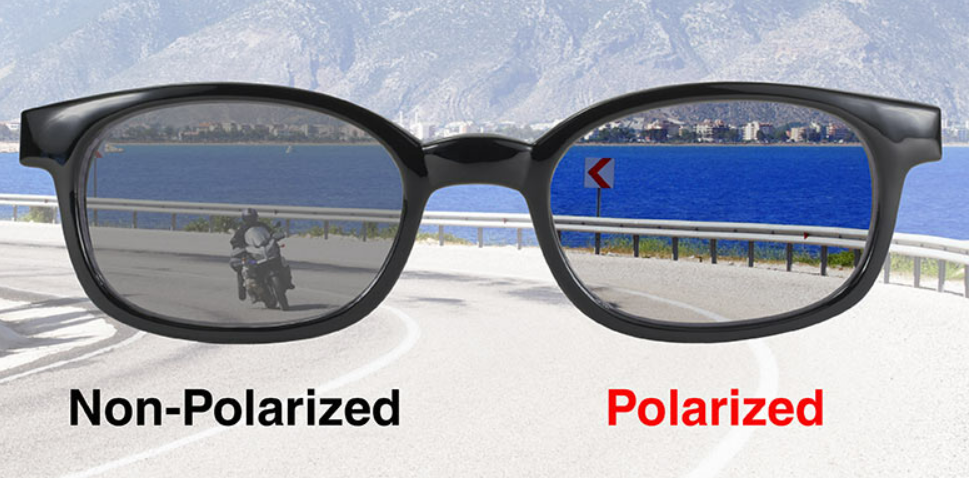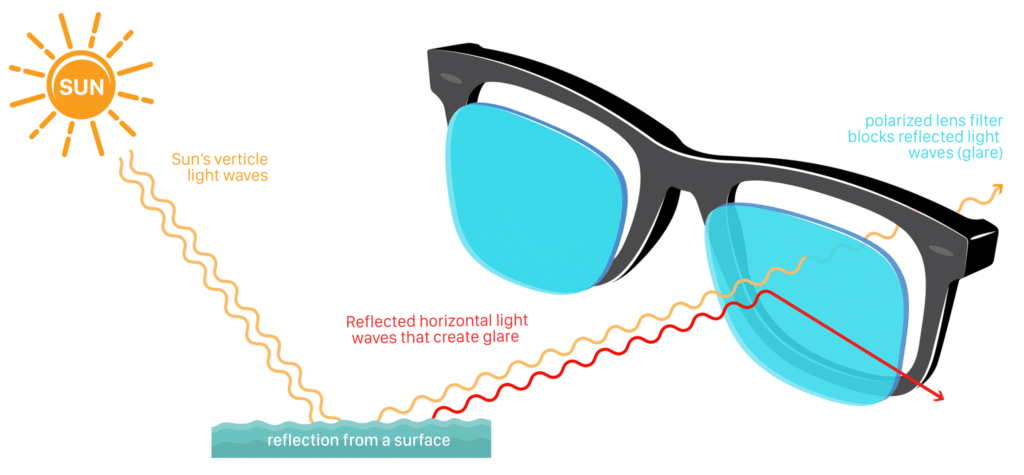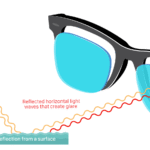Are you tired of squinting on a sunny day, the glare from the water or the road making it difficult to see? Do you find yourself experiencing eye strain and headaches after spending time outdoors? If so, you’re not alone. Millions of people worldwide struggle with the challenges posed by intense sunlight and reflective surfaces. The good news is that there’s a solution: polarized sunglasses. These aren’t just ordinary sunglasses; they’re engineered to significantly reduce glare and enhance visual clarity, offering a superior visual experience in bright conditions.
In today’s world, where we spend more time outdoors and engage in activities like driving, fishing, skiing, and boating, the need for effective eye protection is greater than ever. The sun’s rays, particularly the harmful UV rays, can cause significant damage to our eyes, leading to conditions like cataracts and macular degeneration. While regular sunglasses offer some protection, they often fall short when it comes to dealing with glare, which is the primary culprit behind visual fatigue and discomfort. This is where polarized sunglasses step in, providing a unique solution to this common problem.

Polarized sunglasses are a popular choice among outdoor enthusiasts, athletes, and anyone who values clear vision. They are specifically designed to filter out horizontal light waves, the ones that cause glare. This makes them ideal for activities where reflective surfaces are prevalent, such as water, snow, and roads. The benefits of using polarized sunglasses extend beyond just comfort; they can also improve safety, enhance performance, and protect your long-term eye health. Understanding how polarized sunglasses work, their advantages, and how to choose the right pair is crucial for maximizing their benefits.
This comprehensive guide will delve into the science behind polarized sunglasses, exploring their construction, the benefits they offer, and how they compare to non-polarized sunglasses. We’ll also cover practical aspects, such as how to identify polarized lenses, how to choose the right pair for your needs, and how to care for them. Whether you’re a seasoned outdoor adventurer or simply looking for better vision on a sunny day, this article will provide you with all the information you need to make an informed decision about polarized sunglasses. Get ready to see the world in a whole new light!
The Science Behind Polarized Sunglasses
Understanding how polarized sunglasses work begins with understanding the nature of light. Light, in its natural state, vibrates in all directions. When light hits a surface, like water, snow, or a road, it often reflects, and this reflected light tends to vibrate horizontally. This horizontally vibrating light is what we perceive as glare. Glare is not only distracting and uncomfortable, but it can also obscure our vision, making it difficult to see clearly, especially in bright conditions.
How Polarization Works
Polarized sunglasses contain a special filter that blocks or absorbs a significant portion of this horizontally vibrating light. This filter is made up of a chemical film that is aligned in a specific direction, acting like a Venetian blind for light. Only light waves that are aligned with the filter’s orientation can pass through. This is why polarized sunglasses are so effective at reducing glare.
The process of polarization is akin to a gatekeeper for light. Imagine light waves as a crowd of people trying to pass through a narrow gate. In normal light, the people (light waves) are moving in all directions, causing a bottleneck and confusion (glare). The polarized filter acts as the gate, allowing only people (light waves) moving in a specific direction to pass through, thus reducing the chaos (glare) and improving clarity. This process significantly reduces the intensity of the reflected light, making it easier to see and reducing eye strain.
The Role of the Polarizing Filter
The heart of polarized sunglasses is the polarizing filter. This filter is typically a thin, transparent sheet of material that is treated with a chemical substance. This chemical substance is aligned in a specific direction during the manufacturing process. When light passes through this filter, the horizontally vibrating light waves are either absorbed or blocked, while the vertically vibrating light waves are allowed to pass through. This selective filtering is what gives polarized sunglasses their unique ability to reduce glare.
The efficiency of a polarizing filter is measured by its polarization efficiency, which is the percentage of glare that is blocked. High-quality polarized sunglasses will have a polarization efficiency of 99% or higher. The filter’s effectiveness is also influenced by its construction and the quality of the materials used. Lower-quality filters may not be as effective at blocking glare and could also distort the wearer’s vision.
The Physics of Light and Reflection
To fully grasp the function of polarized sunglasses, one must also understand the physics of light and reflection. When light strikes a surface at an angle, a portion of it is reflected, and a portion is absorbed. The angle of incidence, the angle at which light strikes the surface, determines the degree of polarization. At a specific angle, known as Brewster’s angle, the reflected light becomes almost completely polarized.
This principle is most evident when light reflects off of a smooth, horizontal surface, such as water. The reflected light becomes horizontally polarized, creating significant glare. Polarized sunglasses are particularly effective at reducing glare from these surfaces because they block the horizontally polarized light waves. By blocking this glare, polarized sunglasses improve visual clarity, reduce eye strain, and enhance the wearer’s ability to see objects beneath the surface of the water or snow.
Manufacturing Processes
The manufacturing of polarized lenses involves several steps. The process often begins with a transparent plastic sheet. This sheet is then stretched or treated to align the molecules in a specific direction. The polarizing filter is then incorporated into the lens, typically by applying a thin layer of a polarizing film or by embedding the film within the lens material.
The lens is then coated with protective layers, such as scratch-resistant coatings and UV protection coatings. These coatings enhance the durability and performance of the lenses. The entire manufacturing process is carefully controlled to ensure that the lenses provide optimal glare reduction and visual clarity. Different manufacturers may use proprietary processes and materials, but the fundamental principles remain the same.
Injection molding is a common method used to create the lens shape. This method allows for precise control over the lens’s geometry and the inclusion of the polarizing filter. Another method is lamination, where the polarizing filter is sandwiched between layers of the lens material. This method provides enhanced durability and protection for the polarizing filter.
Benefits of Using Polarized Sunglasses
The advantages of polarized sunglasses extend far beyond simple visual comfort. They offer a wide range of benefits for various activities and environments. These benefits make polarized sunglasses a valuable investment for anyone who spends time outdoors or works in environments with significant glare. From improving visual clarity to enhancing safety, the advantages are substantial.
Improved Visual Clarity and Reduced Glare
The most immediate and noticeable benefit of polarized sunglasses is improved visual clarity. By blocking the horizontally polarized light that causes glare, polarized sunglasses make it easier to see in bright conditions. This is especially helpful when driving, as it reduces the glare from the road surface, oncoming headlights, and the windshield. The result is a clearer and more comfortable view, reducing eye strain and fatigue.
When fishing, polarized sunglasses allow you to see below the surface of the water, making it easier to spot fish and other underwater objects. For skiers and snowboarders, they reduce glare from the snow, improving visibility and helping to identify bumps and other obstacles. In any outdoor activity, polarized sunglasses provide a significant advantage in terms of visual acuity and comfort.
Enhanced Color Perception
Polarized lenses can also enhance color perception. By reducing glare and improving visual clarity, they allow the wearer to see colors more accurately and vividly. This is particularly beneficial in outdoor environments where colors can appear washed out due to glare. With polarized sunglasses, colors appear more vibrant and true to life, enhancing the overall visual experience.
This enhanced color perception is especially noticeable in situations where colors are critical for visual tasks, such as in sports or outdoor photography. The ability to see colors accurately can improve performance and make the experience more enjoyable. Furthermore, the reduced glare also minimizes the distortion of colors, resulting in a more natural and pleasant visual sensation.
Reduced Eye Strain and Fatigue
Prolonged exposure to glare can cause significant eye strain and fatigue. The constant squinting and effort to see through the glare can lead to headaches, blurred vision, and other uncomfortable symptoms. Polarized sunglasses significantly reduce eye strain by eliminating the need to squint. This is due to the lenses effectively blocking glare, allowing the eyes to relax and focus more easily.
By minimizing the need to squint, polarized sunglasses help prevent eye fatigue, allowing you to stay more comfortable and focused for longer periods. This is particularly important for activities that require sustained visual attention, such as driving, reading, or participating in outdoor sports. The reduction in eye strain can also contribute to a reduction in headaches and other symptoms associated with visual fatigue.
Improved Safety
Polarized sunglasses can enhance safety in various situations. When driving, they reduce the glare from the road surface and oncoming headlights, improving visibility and making it easier to react to potential hazards. They can also help to reduce the risk of accidents caused by visual impairment.
In outdoor activities, polarized sunglasses can help to identify obstacles and hazards that might otherwise be obscured by glare. For example, when fishing, they can help you see underwater obstructions, preventing accidents. For skiers and snowboarders, they can improve visibility on the slopes, making it easier to navigate and avoid collisions. The enhanced visual clarity provided by polarized sunglasses translates directly to improved safety in many different settings.
UV Protection
In addition to reducing glare, most polarized sunglasses also offer UV protection. UV rays can damage the eyes and increase the risk of developing cataracts, macular degeneration, and other eye conditions. Polarized sunglasses block both UVA and UVB rays, providing crucial protection against these harmful rays.
It’s essential to choose polarized sunglasses that offer 100% UV protection. This is typically indicated on the product label. Wearing polarized sunglasses with UV protection is a simple but effective way to safeguard your eyes from the damaging effects of the sun’s rays. Regular use of sunglasses with UV protection is a proactive measure in maintaining long-term eye health.
How to Choose the Right Polarized Sunglasses
Choosing the right pair of polarized sunglasses can seem daunting, given the wide variety of options available. However, by considering a few key factors, you can select sunglasses that meet your specific needs and preferences. These factors include the type of activity, the lens color, the frame style, and the level of UV protection.
Consider Your Activities
The type of activity you engage in will influence the best type of polarized sunglasses for you. For example, if you’re primarily driving, you’ll want sunglasses with a comfortable fit and a lens color that enhances visibility in various lighting conditions. For fishing, you’ll want sunglasses that effectively reduce glare from the water’s surface and allow you to see underwater objects.
For sports, you might consider sunglasses with a secure fit and impact-resistant lenses. Understanding the specific demands of your activities will help you narrow down your choices. Consider the environment in which you’ll be using the sunglasses. Will you be in bright sunlight, cloudy conditions, or a mix of both? The answers will help you to select the best lens color and features.
Lens Color Options
The lens color of your sunglasses can significantly affect your visual experience. Different lens colors are designed to optimize vision in different environments and for different activities.
- Gray lenses are a versatile choice, providing true color perception and reducing overall brightness. They are suitable for general use and are excellent for driving.
- Brown or amber lenses enhance contrast and depth perception, making them ideal for activities like fishing and golf. They are also good for partly cloudy conditions.
- Green lenses offer good color perception and reduce glare while maintaining balanced color transmission.
- Yellow or orange lenses enhance contrast in low-light conditions, making them suitable for overcast days or activities like skiing.
- Blue or purple lenses are stylish and offer good color perception, but may not be ideal for all activities.
Experimenting with different lens colors can help you find the perfect pair for your needs. Consider the specific activities you’ll be using the sunglasses for and the environmental conditions you’ll be facing.
Frame Styles and Materials
The frame style and materials are crucial for comfort, fit, and durability. Consider the shape of your face and choose a frame style that complements your features.
- Wrap-around frames provide excellent coverage and are popular for sports.
- Aviator frames are a classic choice that suits many face shapes.
- Wayfarer frames are a versatile option suitable for everyday wear.
Frames can be made from various materials, including plastic, metal, and composite materials. Plastic frames are lightweight and affordable, while metal frames offer durability and a more refined look. Composite materials combine the benefits of both plastic and metal.
Ensure that the sunglasses fit comfortably and securely. They should not slip down your nose or press against your temples. The fit is crucial for maximizing the benefits of polarized sunglasses.
Checking for Polarization
Before purchasing polarized sunglasses, it’s important to verify that they are, in fact, polarized. There are several methods for doing this.
- The LCD Test: Hold the sunglasses up to a computer screen or a digital display. Rotate the sunglasses 90 degrees. If the lenses are polarized, the image will appear to darken or disappear.
- The Glare Test: Look at a reflective surface, such as a window or the surface of water. If the sunglasses are polarized, the glare will be significantly reduced.
- The Two-Sunglasses Test: Hold one pair of polarized sunglasses in front of another. Rotate one pair. If the lenses are polarized, the lenses will appear to darken or become completely opaque.
These tests are a simple way to ensure you are purchasing genuine polarized sunglasses. If you are unsure, seek advice from a trusted optician or retailer.
Caring for Your Polarized Sunglasses
Proper care and maintenance are essential for extending the lifespan of your polarized sunglasses and ensuring that they continue to provide optimal performance. Regular cleaning, proper storage, and avoiding harsh conditions will help protect your investment.
Cleaning Your Sunglasses
Regular cleaning is vital to maintain the clarity of your lenses. Use a microfiber cloth specifically designed for cleaning eyewear. These cloths are soft and will not scratch the lenses. Avoid using paper towels, tissues, or rough materials, as they can scratch the lenses.
To clean your sunglasses, gently wipe the lenses with the microfiber cloth. If there are smudges or debris, rinse the lenses with lukewarm water and a mild soap. Dry the lenses with the microfiber cloth. Avoid using harsh chemicals or solvents, as they can damage the lenses and coatings.
Storage and Protection
When not in use, store your polarized sunglasses in a protective case. This will help prevent scratches, dust, and other damage. Avoid storing the sunglasses in direct sunlight or extreme temperatures, as this can damage the lenses and frames.
When you’re not wearing your sunglasses, place them in their case. If a case is not available, place the sunglasses face down on a clean surface to prevent scratches. Be mindful of the environment and keep your sunglasses away from abrasive materials or surfaces that could cause damage.
Repair and Maintenance
If your sunglasses are damaged, such as a scratched lens or a broken frame, consider professional repair. An optician or eyewear specialist can often repair minor damage. Avoid attempting to repair the sunglasses yourself, as this could cause further damage.
If the lenses are significantly scratched, it may be necessary to replace them. Consult with a professional to determine the best course of action. Proper maintenance and care will help keep your polarized sunglasses in excellent condition and extend their useful life.
Summary: Key Takeaways on Polarized Sunglasses
Polarized sunglasses are much more than just a fashion accessory; they are a valuable tool for enhancing vision, improving comfort, and protecting your eyes from the harmful effects of glare and UV radiation. The fundamental principle behind polarization is the ability to block horizontally vibrating light waves, which are the primary cause of glare. This unique feature distinguishes polarized sunglasses from standard sunglasses and offers a superior visual experience in bright conditions.
The advantages of wearing polarized sunglasses are numerous and significant. They enhance visual clarity, reduce eye strain and fatigue, and improve safety in various situations, from driving to water sports. Furthermore, most polarized sunglasses offer UV protection, safeguarding your eyes from the long-term damage caused by the sun’s rays. The benefits of using polarized sunglasses extend to various activities and lifestyles, making them a worthwhile investment for anyone who spends time outdoors.
Choosing the right pair of polarized sunglasses involves considering several factors. The type of activity you engage in, the lens color, frame style, and the level of UV protection are all important considerations. Different lens colors are optimized for specific environments and activities, and selecting the right color can significantly enhance your visual experience. Furthermore, proper care and maintenance, including regular cleaning and careful storage, are essential for extending the lifespan of your sunglasses and ensuring they continue to perform effectively.
In conclusion, polarized sunglasses are a valuable investment for anyone seeking improved visual comfort, enhanced safety, and protection from the sun’s harmful rays. Understanding the science behind polarization, the benefits of polarized lenses, and how to choose the right pair will empower you to make an informed decision and enjoy a clearer, more comfortable visual experience. By prioritizing eye health and investing in quality eyewear, you can protect your vision and enjoy the world around you with greater clarity and comfort.
Frequently Asked Questions (FAQs)
What is the main difference between polarized and non-polarized sunglasses?
The primary difference lies in the ability of polarized sunglasses to reduce glare. Polarized sunglasses have a special filter that blocks horizontally vibrating light waves, which cause glare. Non-polarized sunglasses offer general shading but do not specifically address glare.
How can I tell if my sunglasses are polarized?
You can use a few simple tests. One is to hold the sunglasses up to a computer screen and rotate them; if the image darkens or disappears, they are likely polarized. You can also look at a reflective surface like water and see if the glare is significantly reduced.
Are polarized sunglasses better for driving?
Yes, polarized sunglasses are often recommended for driving because they reduce glare from the road surface, other vehicles, and the windshield. This can improve visibility and reduce eye strain, making driving safer and more comfortable.
Do polarized sunglasses block UV rays?
Most polarized sunglasses also offer 100% UV protection, which is essential for protecting your eyes from the harmful effects of the sun’s ultraviolet rays. Always check the product label for UV protection information.
Can I use polarized sunglasses for all activities?
Polarized sunglasses are excellent for many outdoor activities, especially those involving reflective surfaces like water or snow. However, they may not be ideal for all situations, such as viewing LCD screens, as they can sometimes interfere with the display. Consider the specific activity and environment when choosing polarized sunglasses.



